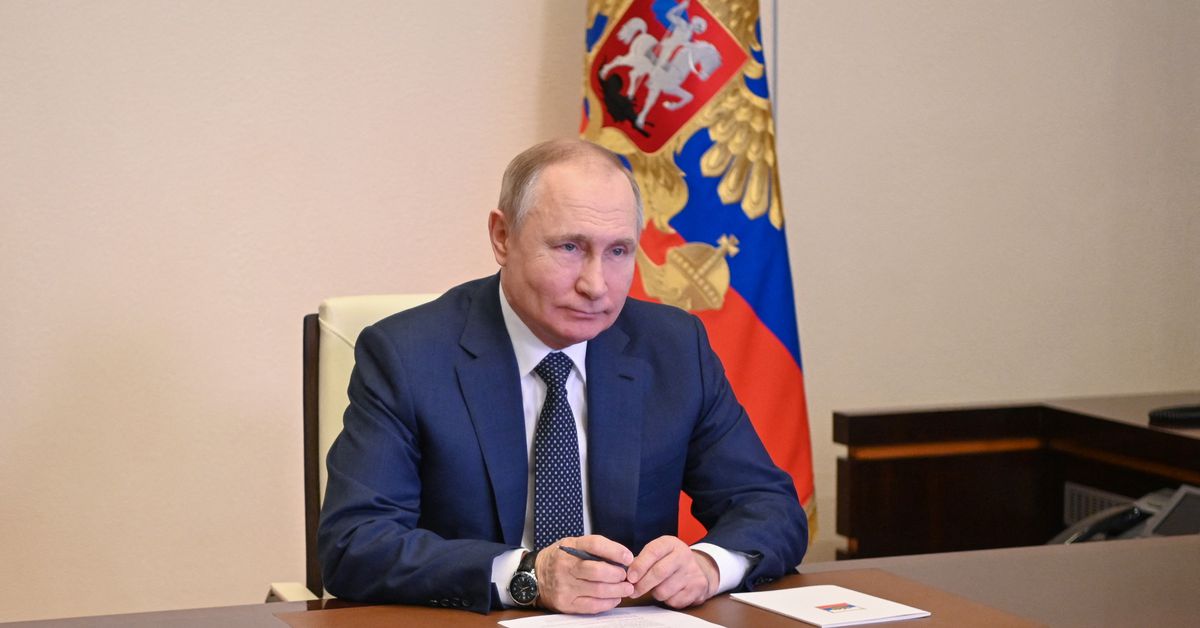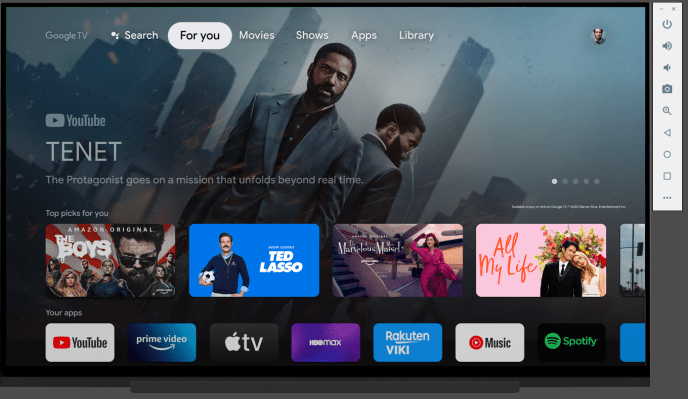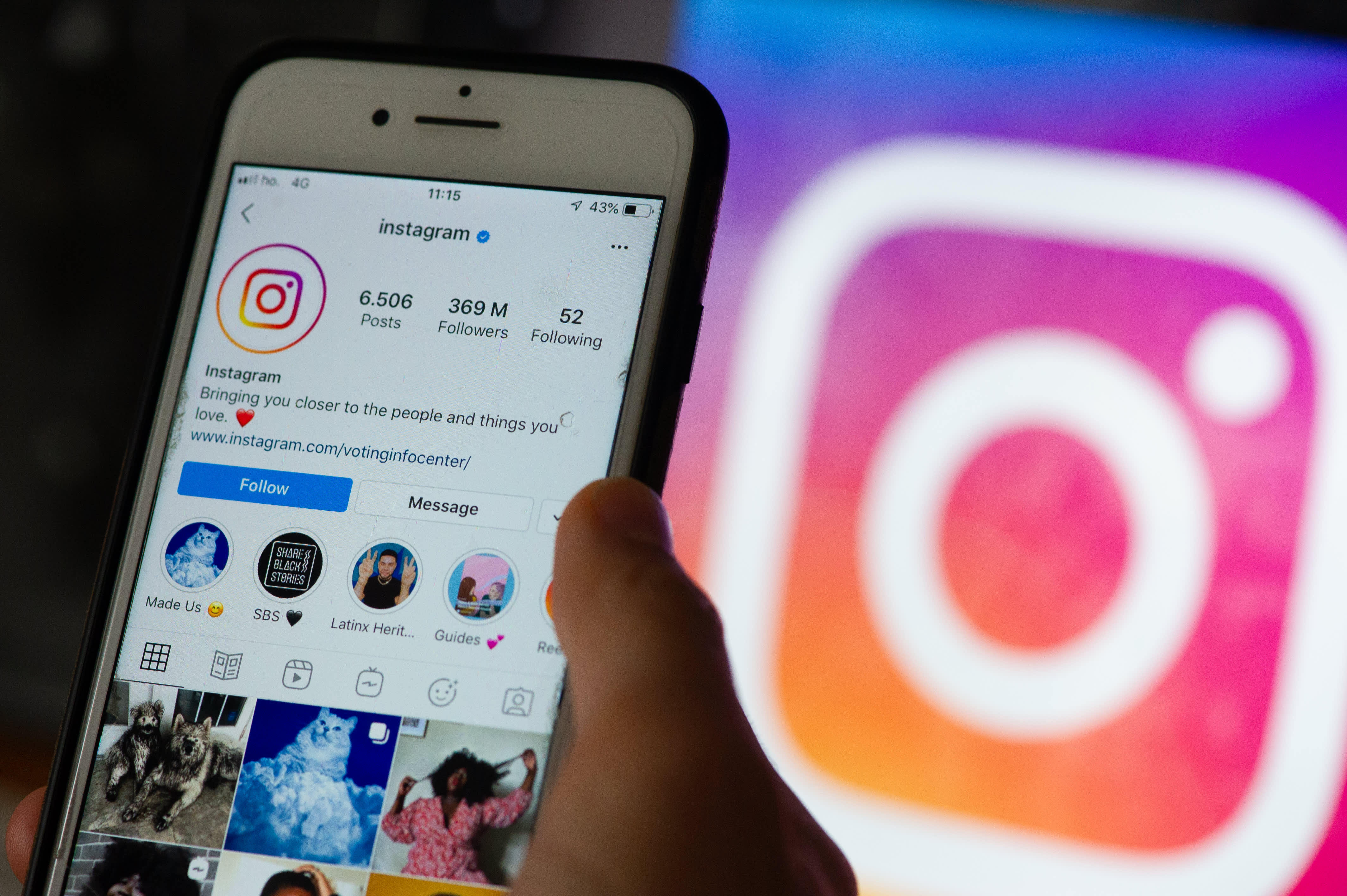DJI Avata vs DJI FPV: Which first-person drone is best for you?
Here's a side-by-side comparison of the new DJI Avata and the DJI FPV, two first-person perspective drones that come with VR goggles.
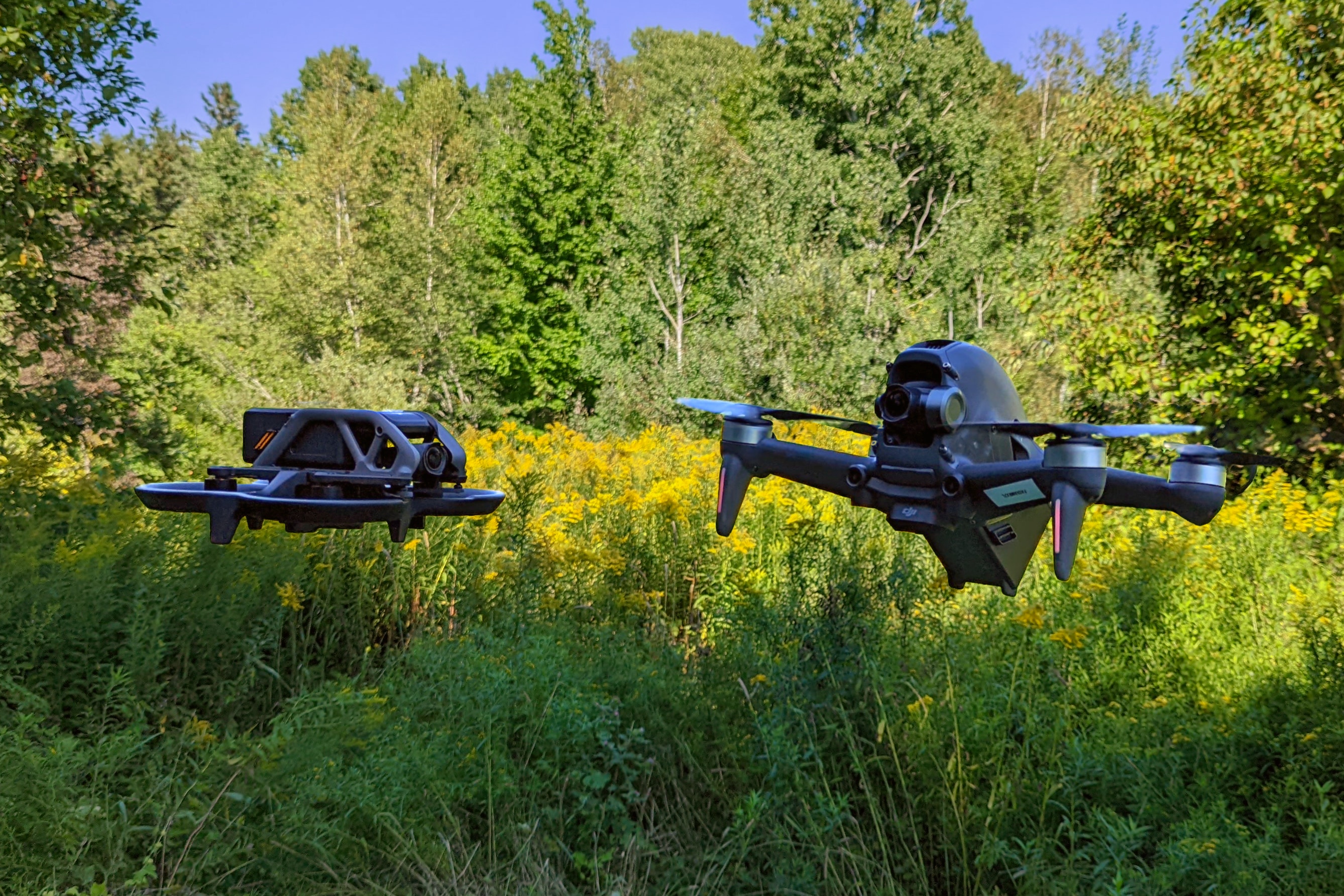
The newly released DJI Avata and the year-and-a-half-old DJI FPV include head-mounted displays and, when paired with DJI’s unique Motion Controller, flying becomes much more intuitive. It’s hard to go wrong with any DJI drone, but if you’re looking for the most immersive experience you can find, these are the only models that come with the equivalent of a VR headset that make it feel like you’re really flying, not just piloting a remote aircraft.
If you already own a DJI FPV, you might be wondering what’s new with the Avata and whether it’s worth getting the smaller drone. For those shopping for a first-person perspective drone and intrigued by DJI’s goggles and unique controller, the challenge is picking between the DJI Avata and FPV drone, both of which are super-fast, yet easy to fly — even for a beginner.
Which DJI drone is the fastest?
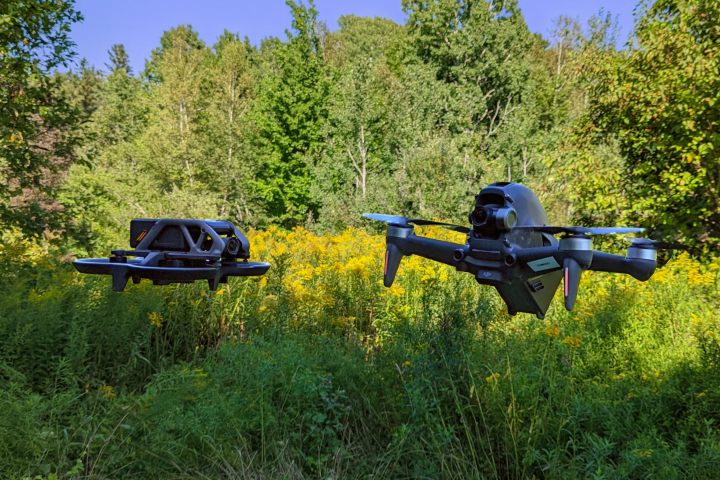
When it comes to speed, the DJI FPV would easily win a drag race against the Avata. The DJI FPV is a larger and more powerful drone, with strong motors and five-inch propellers with thre blades. The Avata’s 5-bladed propellers span three inches, and the motors are smaller as well. The FPV can reach speeds of 34mph in normal mode, 60mph in sport, and a startlingly fast 87mph in manual mode.
The Avata is very fast but can’t keep up with its bigger sibling, reaching 18mph in normal, 31mph in sport, and 60mph in manual mode. Both drones can accelerate at an incredible rate, so caution must be used when squeezing the trigger to move, particularly if you’re flying indoors. Crossing a room takes a fraction of a second at full throttle.
DJI Avata test flight proves it's quick, agile ... and durable!
While the Avata doesn’t stand a chance in a straight-ahead, full-throttle race, its smaller size and maneuverability might give the DJI FPV a challenge in an obstacle course. Here’s a short YouTube video from the channel Avata Time demonstrating how easy it is for you to maneuver the DJI Avata after only a few test flights. The video ends with a crash, but the Avata was unharmed, since the propeller guards and frame protect the more delicate parts.
Side-by-side size comparison
The DJI Avata is tiny — even smaller than an unfolded DJI Mini 3 Pro. At 7-by-7-by-3 inches, the Avata can fit through spaces that would be impossible for the DJI FPV, which is 12-by-10-by-5 inches. The DJI Avata is small enough to fit in almost any case or bag, and the propeller guards protect the blades when you’re traveling. With the FPV drone, the propellers should be removed before you stow it away to prevent bending or breaking the blades.
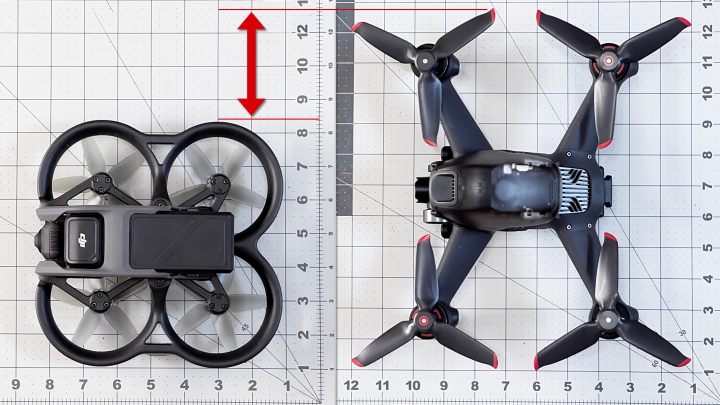
The compact size of the DJI Avata causes a minor annoyance, however. The MicroSD card slot is placed behind a cover on the body, but access is very tight since you have to reach between the propeller blades. Even a person with small fingers will find it challenging to take a card out with one hand and there’s a danger of dropping the card, which could be heartbreaking if it was lost after capturing some amazing shots with the Avata.
The DJI Avata at 410 grams (0.9 pounds) is much lighter than the FPV drone’s 795 grams (1.75 pounds). Since each is over 250 grams, you’ll need to register these drones before flying them.
DJI Goggles 2 vs Goggles V2
DJI’s newest headset, Goggles 2, is designed specifically for the DJI Avata. The name is somewhat confusing, since the headset that ships with the DJI FPV is called Goggles V2. There’s only a one-letter difference in the name. The Avata is available to order with either headset, so shop carefully. The DJI headset with a ‘V’ in the name is the older model, but in some ways, it’s better.
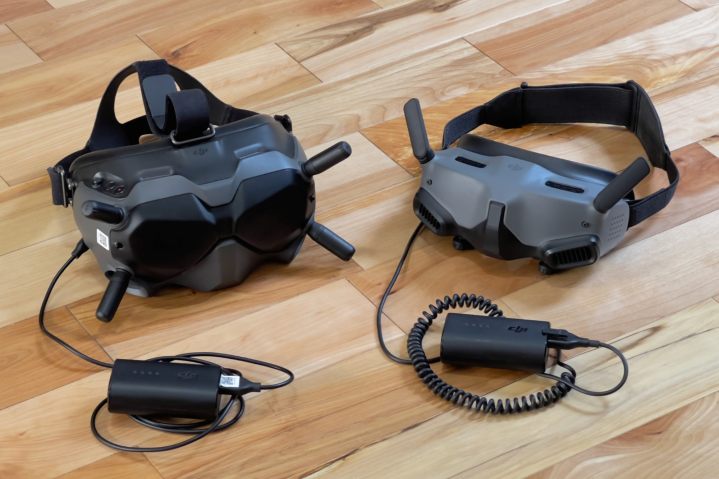
The older Goggles V2 costs a little more and features four antennas, potentially giving you more flight range and handling interference better than the newer design of the Goggles 2 with two antennas. The latest headset has the advantage of being lighter and having a brighter, sharper 1080p display, while the Goggles V2’s resolution is 720p. The Avata’s Goggles 2 also has diopter adjustments to maximize comfort and sharpness for your eyes.
Motion Controller vs. joystick control
The DJI Avata comes standard with the Motion Controller. This is the most intuitive way to fly a drone, and it works beautifully with a head-mounted display. A white circle is overlaid onto the camera view and, when the throttle trigger is squeezed, the drone flies in that direction. The position of the circle is controlled by tilting the motion controller up, down, right, and left, making maneuvering the drone almost as easy as point and click.
The DJI FPV is also compatible with the Motion Controller, though it comes with a joystick controller. The Motion Controller is an optional accessory for the DJI FPV that adds $199 to the cost.
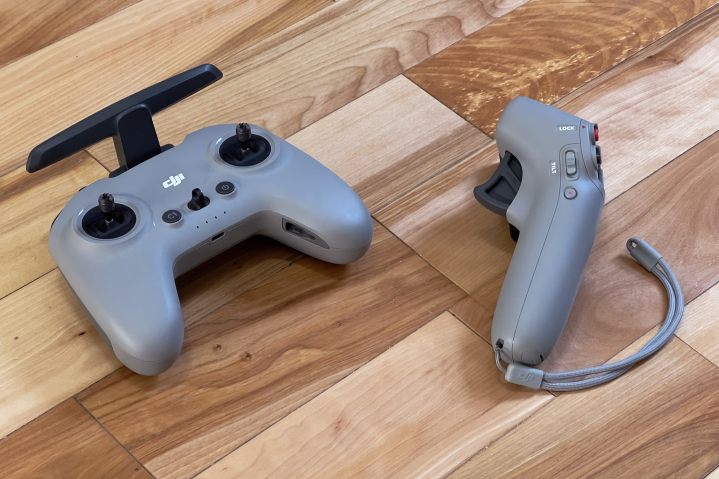
As nice as the Motion Controller is, there are advantages to the classic joystick-based remote control that’s included with the DJI FPV. Most notably, you can easily fly in one direction while pointing the camera in another direction. If video production is your primary purpose for getting one of these drones, this is the more versatile controller.
Manual mode, which unlocks the fastest speed possible with the DJI Avata and FPV drones, is only possible with the DJI FPV Remote Controller 2 that uses joysticks. This is a separate purchase for the Avata, which would add $199 to its cost.
Which is noisier?
The DJI FPV and Avata have high-performance motors, and the propellers make a significant amount of noise when compared to slower DJI drones. The Avata’s smaller propellers create a higher pitch than the FPV, which makes it more noticeable.
On an Apple Watch decibel meter, the DJI FPV measured 73dB outdoors and 83dB indoors, while the Avata reached 76dB outdoors and 86dB indoors. The baseline noise levels were 45dB outdoors and 43dB indoors. That means the noise levels are about the same for the DJI FPV and Avata, even though the Avata might seem louder due to the higher frequency sound it makes. It’s about the same noise level as a lawn mower.
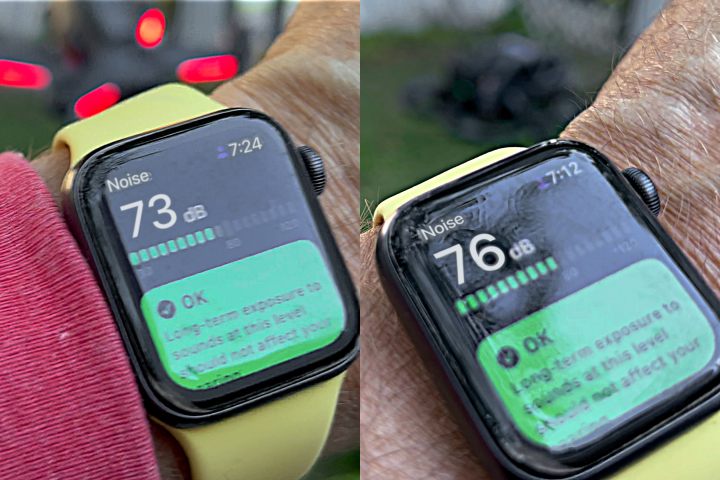
The DJI FPV’s lower pitch is less noticeable, but the drone makes a curious power-up sound where the motors vibrate in a somewhat ominous-sounding trill that’s reminiscent of sci-fi movies. The Avata powers on with a subtle vibration of the motors and a cheerful chime.
Which has the best camera?
The DJI Avata has a greatly improved camera, featuring a larger 1/1.7-inch sensor, with a 48MP resolution and up to 150Mbps video quality. The DJI FPV’s smaller 1/2.3-inch sensor can capture 12MP images and 120Mbps video. That means the Avata will be less likely to have motion artifacts in the video while capturing sharper images and delivering better low-light performance.
 This un-retouched DJI Avata photo was taken at sunset. Cropped to a 3:2 aspect ratio.
This un-retouched DJI Avata photo was taken at sunset. Cropped to a 3:2 aspect ratio.The DJI FPV still records nice quality video in good conditions, so the difference might not be that noticeable. If you like recording early morning, sunset, or nighttime videos, the Avata will offer a higher fidelity result.
Both DJI drones can capture 4K resolution at up to 60fps and 1080p at up to 120fps. The Avata adds 2.7K video at 120fps, making slow-motion videos crisper. The Avata definitively wins the camera round, which makes sense for a drone built with newer technology.
Pricing
The DJI Avata Pro View Combo that includes the new Goggles 2 and a Motion Controller has everything you need to start flying for $1,388. The DJI FPV Combo includes Goggles V2 and a joystick controller for $999. To get an FPV drone equipped like an Avata, you have to add the Motion Controller at $199 and the propeller guard at $25, for a bundle cost of $1,223.
If you need the best transmission signal possible, DJI sells the Avata Fly Smart Combo that includes the four-antenna Goggles V2 and Motion Controller. The price for this Avata bundle drops to $1,168, less expensive than the equivalent FPV bundle.
Of course, to fly in manual mode, the Avata needs a DJI Remote Controller that costs $2000. If you don’t want the Motion Controller, the DJI FPV becomes a much better deal at $1000 than a similar Avata bundle. DJI discounts the price on its combos and kits that include more than one accessory, but you can build your own bundle since the drones, accessories, and spare parts are available separately.
The DJI Avata is a solid step up
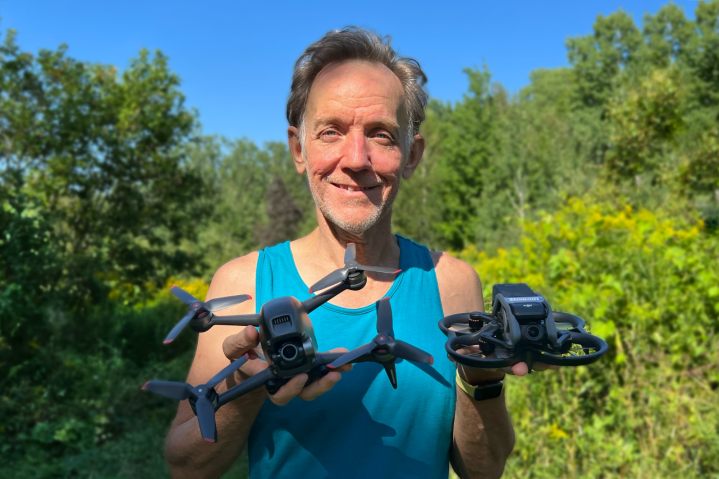 Photo by Tracey Truly
Photo by Tracey TrulyThe bottom line when shopping for a drone or considering upgrading is to think about your own needs and preferences. If you want the best camera quality from a DJI drone that comes with a headset, the Avata has a clear advantage. If speed is more important, the DJI FPV is the fastest model.
For comfort and safety, the standard Avata bundle includes propeller guards that make it a better choice around people and animals or when used indoors. It’s more fun and productive to fly when you feel safe, and the Avata’s Motion Controller makes this a good choice for a beginner. Its speed potential opens up plenty of room to learn and grow.
The DJI FPV is great for flying in challenging conditions where more power and range might be needed. With its amazing speed, it will satisfy those looking for a more thrilling flight. However, the DJI Avata is going to suit more people with its compact, friendly design, and better camera quality.

 Koichiko
Koichiko 








